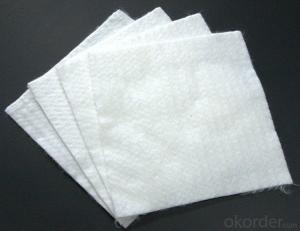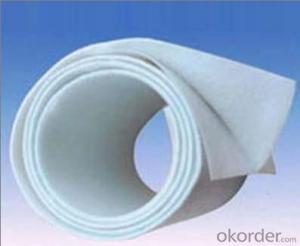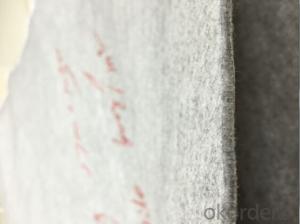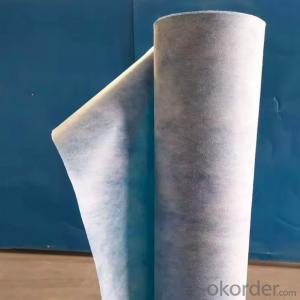High Quality Polyester Continuous Filament Nonwoven Geotextile
- Loading Port:
- Qingdao
- Payment Terms:
- TT or L/C
- Min Order Qty:
- 20000 m²
- Supply Capability:
- 2500000 m²/month
OKorder Service Pledge
OKorder Financial Service
You Might Also Like
1. Introduction of Polyester Continuous Filament Nonwoven Geotextile:
Good flexibility, permeability, filtration, separation and easy for construction.
2. Application of Polyester Continuous Filament Nonwoven Geotextile:
Geotextile has excellent permeability, acquired, durability, which can be widely used in railway, highway, movement hall,
Dams, hydraulic structures, hence hole, coastal shoal, reclamation, environmental protection and other projects.
The main products are Synthetic staple fibers needle punched non woven geotextiles and slit and spilt film yarn woven geotextiles.
Filtration of soils in drainage applications by retaining soil particles while allowing for the free flow of water
Separation and stabilization in road and railway construction
Prevention of soil movement in erosion control measures
Cushioning and protection in many containment projects
3. Feature of Polyester Continuous Filament Nonwoven Geotextile:
1. Can withstand construction installation stresses
2. UV (Ultra Violet) Stabilized
3. High Chemical Resistance
4. Optimum Elongation
Produced from high quality fibers, Nonwoven Geotextiles are needle punched to form a strong fabric that retains its dimensional stability and is resistant to damage from construction stresses.
JIANYI Nonwoven Geotextiles are available in varying strengths and thicknesses to ensure appropriate material selection for your project. Below are our standard weights and sizes.
Specification of Filament Woven Geotextile:
Technical specification of short fiber needle punched non woven geotextile
No. | Item | Specification | Note | ||||||||||
100 | 150 | 200 | 250 | 300 | 350 | 400 | 450 | 500 | 600 | 800 | |||
1 | Weight Variation% | -8 | -8 | -8 | -8 | -7 | -7 | -7 | -7 | -6 | -6 | -6 |
|
2 | Thickness mm≥ | 0.9 | 1.3 | 1.7 | 2.1 | 2.4 | 2.7 | 3.0 | 3.3 | 3.6 | 4.1 | 5.0 | |
3 | Width Variation % | -0.5 | |||||||||||
4 | KN/m≥ | 2.5 | 4.5 | 6.5 | 8.0 | 9.5 | 11.0 | 12.5 | 14.0 | 16.0 | 19.0 | 25.0 | MD and TD |
5 | Elongation at Break % | 25~100 | |||||||||||
6 | CBR Mullen Burst Strength KN ≥
| 0.3 | 0.6 | 0.9 | 1.2 | 1.5 | 1.8 | 2.1 | 2.4 | 2.7 | 3.2 | 4.0 |
|
7 | Sieve Size O90 mm | 0.07~0.2 |
| ||||||||||
8 | Vertical Permeability Coefficient cm/s | K×(10ˉ1~10ˉ3) | K=1.0~9.9 | ||||||||||
9 | Tear Strength KN≥ | 0.08 | 0.12 | 0.16 | 0.20 | 0.24 | 0.28 | 0.33 | 0.38 | 0.42 | 0.46 | 0.6 | MD and TD |
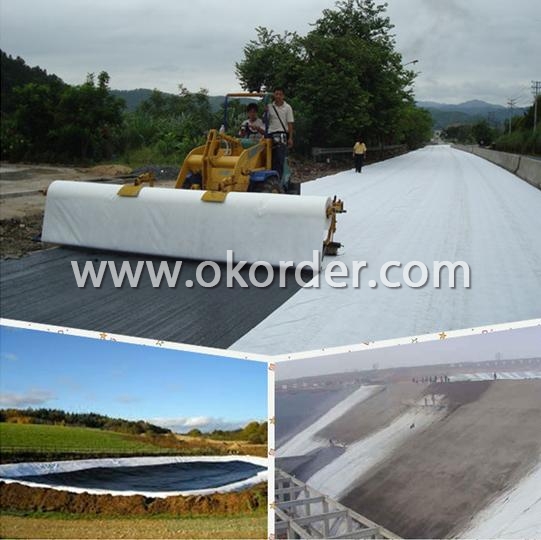
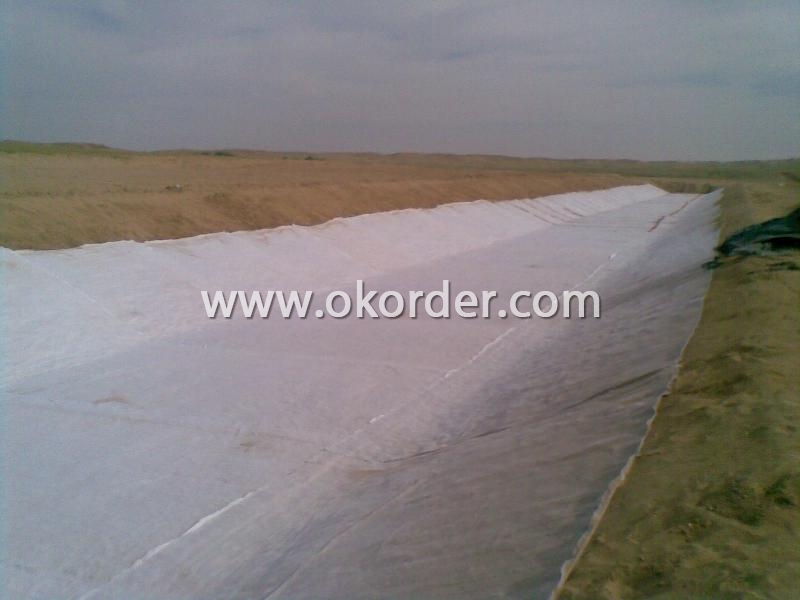
- Q:Manufacture of geotextile machinery
- Non-woven needle machine, I am specializing in the production of geotextiles
- Q:What are the different geotextile installation techniques in erosion control?
- Some of the different geotextile installation techniques in erosion control include trenching, anchoring, stapling, and sowing. Trenching involves digging a trench and placing the geotextile into it, allowing it to filter water runoff and prevent erosion. Anchoring involves securing the geotextile to the ground using stakes or other fasteners to prevent movement. Stapling involves using staples or pins to secure the geotextile to the ground, providing stability and erosion control. Sowing refers to mixing seeds with the geotextile material and then laying it down, allowing vegetation to grow and reinforce the soil. These techniques can be used individually or in combination to effectively control erosion.
- Q:Geotechnical deployment of aging detection of what indicators
- Geotextile aging test: anti - ultraviolet ability. That is, at a certain temperature, the sun under the strong changes in geotextile.
- Q:What are the different factors to consider for geotextile selection in mining applications?
- When selecting geotextiles for mining applications, several factors need to be considered. These include the required strength and durability of the geotextile to withstand the specific mining conditions, such as heavy machinery, abrasion, and chemical exposure. The permeability and filtration capabilities of the geotextile are also crucial to ensure proper drainage and prevent clogging. Additionally, factors like installation ease, cost-effectiveness, and compliance with environmental regulations should be taken into account to make an informed decision for geotextile selection in mining applications.
- Q:The difference between short wire geotextile and filament geotextile
- Geotextile is a collectively, he includes filament geotextile, short wire geotextile, woven geotextile, woven geotextile, hot pressed nonwovens. Polyester filament geotextile color is mainly white, green. Gray two categories. The length of the fiber is greater than 4.5 cm. Strong strength is very high. Looks very good distinction.
- Q:How do geotextiles help in preventing the loss of aggregate in parking lots?
- Geotextiles help in preventing the loss of aggregate in parking lots by acting as a barrier between the aggregate and the underlying soil. This prevents the aggregate from sinking into the soil and being displaced by the weight of vehicles or erosion caused by water runoff. The geotextile material provides stability and reinforcement to the aggregate, helping to maintain its integrity and prolong the lifespan of the parking lot.
- Q:What are the limitations of geotextiles?
- Geotextiles have certain limitations that need to be considered. Firstly, they are not suitable for high load-bearing applications and may require additional reinforcement. Secondly, they may degrade over time due to exposure to UV radiation, leading to a decrease in their effectiveness. Additionally, geotextiles may not be effective in controlling fine particles or preventing the growth of vegetation in certain scenarios. Lastly, they may be susceptible to damage during installation or due to punctures and tearing, requiring careful handling.
- Q:How do geotextiles aid in the reduction of liquefaction?
- Geotextiles aid in the reduction of liquefaction by providing reinforcement and stabilization to the soil. These synthetic fabrics are installed beneath the surface to improve the soil's strength and prevent its excessive movement during seismic activity. By increasing the soil's resistance to liquefaction, geotextiles help to mitigate the potential damage and hazards caused by this phenomenon.
- Q:JTGF80 / 1-2004 "standard" 4.5 Geosynthetics in the treatment of the measured items in the "anchoring length", in the construction design diagram, the provisions of the value of the allowable deviation should be how to implement? Question added: Sorry! I missed a few words. When the construction design is not indicated, the specified value, the allowable deviation value should be implemented? JTGF80 / 1-2004 "standard only write to meet the design, construction requirements. I did not say that the design of the length of the anchorage is how much, can not find the construction technical specifications. So I do not know the provisions of the value of how to allow deviation? More
- Specifically not less than the specified value, does not exceed the allowable deviation. This is the so-called construction by specification! You refer to JTG assessment standard -2004 is correct! I have the data to let you refer to the next / geogrid and geotextile landscape is greater than or equal to 50cm, vertical is greater than or equal to 150com
1. Manufacturer Overview |
|
|---|---|
| Location | Shandong, China |
| Year Established | 2001 |
| Annual Output Value | US$ 5 Million - US$ 10 Million |
| Main Markets | 20.00% North America 20.00% South America 10.00% Eastern Europe 10.00% North America 10.00% Northern Europe 10.00% South Asia 10.00% Western Europe 5.00% Africa 5.00% Mid East |
| Company Certifications | ISO9001; ISO14000 |
2. Manufacturer Certificates |
|
|---|---|
| a) Certification Name | |
| Range | |
| Reference | |
| Validity Period | |
3. Manufacturer Capability |
|
|---|---|
| a)Trade Capacity | |
| Nearest Port | Qingdao Port |
| Export Percentage | 21% - 30% |
| No.of Employees in Trade Department | 5-10 People |
| Language Spoken: | English; Chinese |
| b)Factory Information | |
| Factory Size: | Above 30,000 square meters |
| No. of Production Lines | Above 10 |
| Contract Manufacturing | Design Service Offered; Buyer Label Offered |
| Product Price Range | High; Average |
Send your message to us
High Quality Polyester Continuous Filament Nonwoven Geotextile
- Loading Port:
- Qingdao
- Payment Terms:
- TT or L/C
- Min Order Qty:
- 20000 m²
- Supply Capability:
- 2500000 m²/month
OKorder Service Pledge
OKorder Financial Service
Similar products
New products
Hot products
Hot Searches
Related keywords











